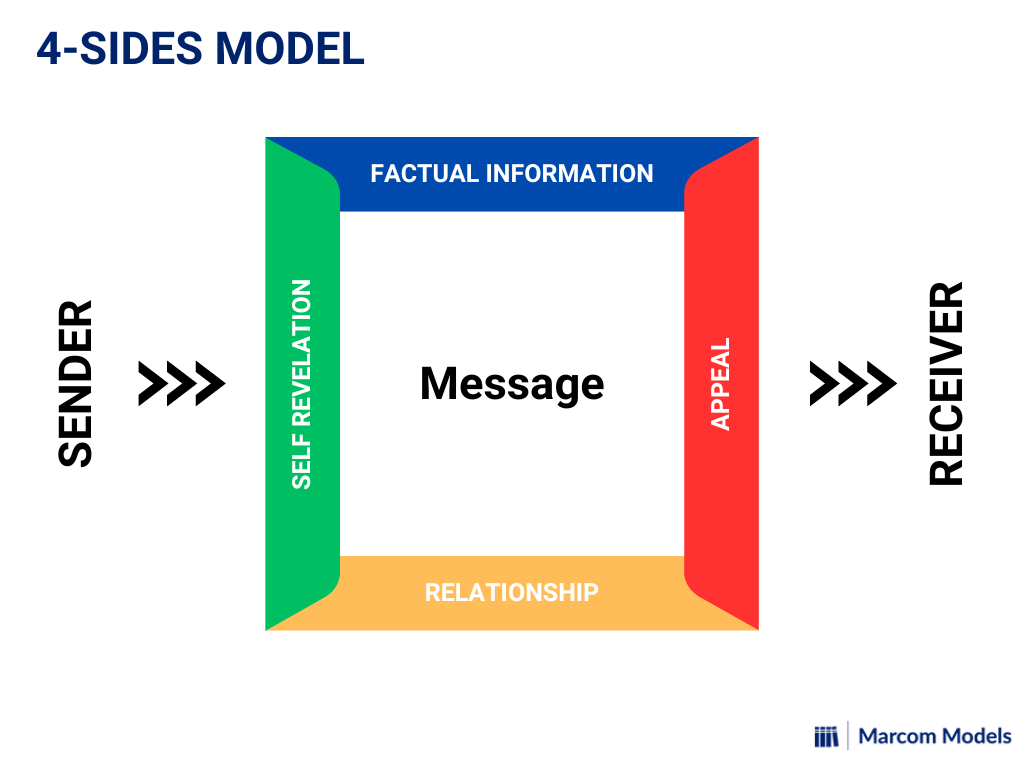Communication is a fundamental aspect of human interaction, both in personal and professional contexts. As such, understanding how communication works and how to improve it is essential for effective communication. One model that can aid in this understanding is the Four Side Model of Communication. In this article, we will discuss what the Four Side Model is, its components, and its advantages. We will also examine criticisms of the model and its limitations.

What is the Four Side Model of Communication?
The Four Side Model of Communication was developed by Friedemann Schulz von Thun, a German psychologist, in the 1970s. The model suggests that any message has four different sides or dimensions, which are:
- The factual aspect: This is the content of the message, i.e., what is being said.
- The self-revealing aspect: This is what the speaker reveals about themselves through the message, such as their emotions, values, or beliefs.
- The relationship aspect: This dimension refers to the relationship between the speaker and the listener. It includes information about how the speaker perceives the listener and how the speaker wants the listener to perceive them.
- The appeal aspect: This dimension is about what the speaker wants the listener to do or how they want the listener to respond.
The Four Side Model of Communication suggests that each of these dimensions is essential to the communication process, and a message may be incomplete if it lacks one or more of these dimensions.
Advantages of the Four Side Model
The Four Side Model of Communication has several advantages. One of the most significant advantages is that it helps people become aware of the different dimensions of communication. This awareness can help individuals be more intentional and thoughtful in their communication, leading to more effective communication and better relationships.
Another advantage of the model is that it can help individuals improve their communication skills. For example, by paying attention to the relationship aspect, individuals can become more aware of how their communication affects others and can adjust their communication style accordingly. Similarly, by focusing on the appeal aspect, individuals can become more skilled at persuading others.
Criticism of the Four Side Model
Despite its many advantages, the Four Side Model of Communication is not without its limitations and criticisms. One example of the misuse of the model is when individuals use it to manipulate or deceive others. For example, a speaker may use the self-revealing aspect of the message to create a false impression of themselves or to make themselves appear more likable or trustworthy.
Another limitation of the model is that it can be difficult to apply in real-life situations. In some situations, it may be challenging to distinguish between the different dimensions of a message, making it challenging to know how to respond effectively. Additionally, some critics argue that the model oversimplifies the complexity of communication, reducing it to four dimensions and ignoring other factors that can influence the communication process.
Compared to other models or theories, the Four Side Model of Communication also has a big flaw. It does not address nonverbal communication explicitly. While nonverbal communication is an essential aspect of communication and can impact how a message is received, the Four Side Model only focuses on the verbal aspects of communication.
Conclusion
The Four Side Model of Communication can be a valuable tool in understanding how communication works. By considering the factual, self-revealing, relationship, and appeal dimensions of communication, individuals can become more aware of how their communication affects others and improve their communication skills. Despite criticisms, such as its potential for misuse, difficulty in application, and oversimplification of the communication process, the Four Side Model of Communication remains a valuable framework for understanding communication and improving communication skills.
References
Dieltjens, S., Heynderickx, P., Dees, M., & Vissers, K. (2014). Linguistic Analysis of Face-to-Face Interviews with Patients with An Explicit Request for Euthanasia, their Closest Relatives, and their Attending Physicians: the Use of Modal Verbs in Dutch. Pain Practice. https://doi.org/10.1111/papr.12076
Lubienetzki, U., & Schüler-Lubienetzki, H. (2022a). Communication Styles and Patterns. Springer Berlin Heidelberg EBooks, 37–55. https://doi.org/10.1007/978-3-662-64437-9_3
Lubienetzki, U., & Schüler-Lubienetzki, H. (2022b). Verbal and Non-verbal Communication. Springer Berlin Heidelberg EBooks, 5–35. https://doi.org/10.1007/978-3-662-64437-9_2
Rostomyan, A., & Ternès, A. (2014). Emotion Management in Business Communication. Brill. https://doi.org/10.1163/9781848882508_011
Scholl, W., Lackner, K., & Grieger, K. (2022). Communication as a Method and as a Topic in Coaching. Springer EBooks, 199–212. https://doi.org/10.1007/978-3-030-81938-5_16
Straeubig, M. (2020). The Communication Problem. Rifl.Unical.It. https://doi.org/10.4396/AISB201906